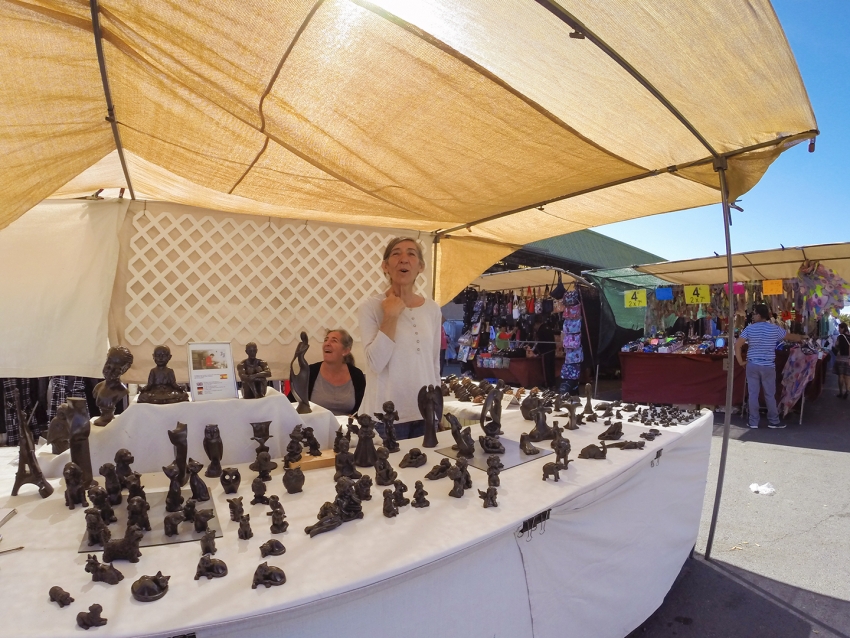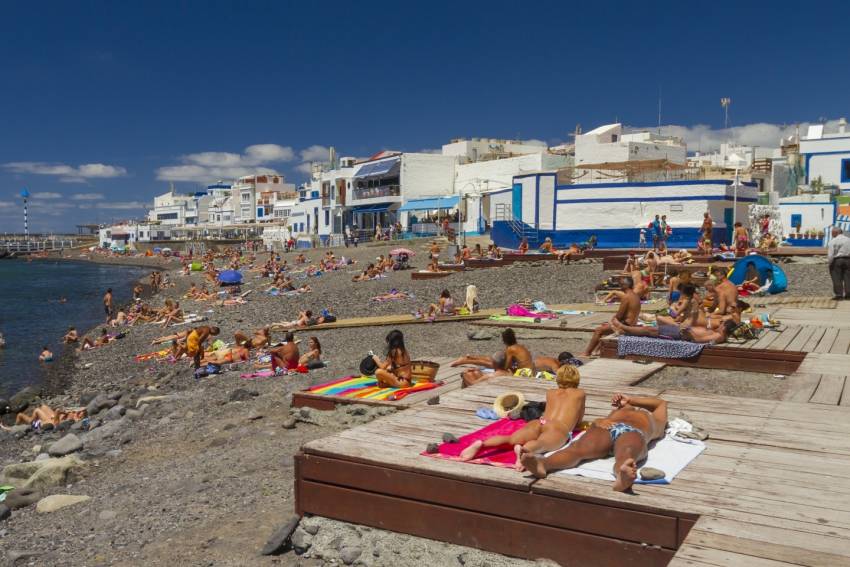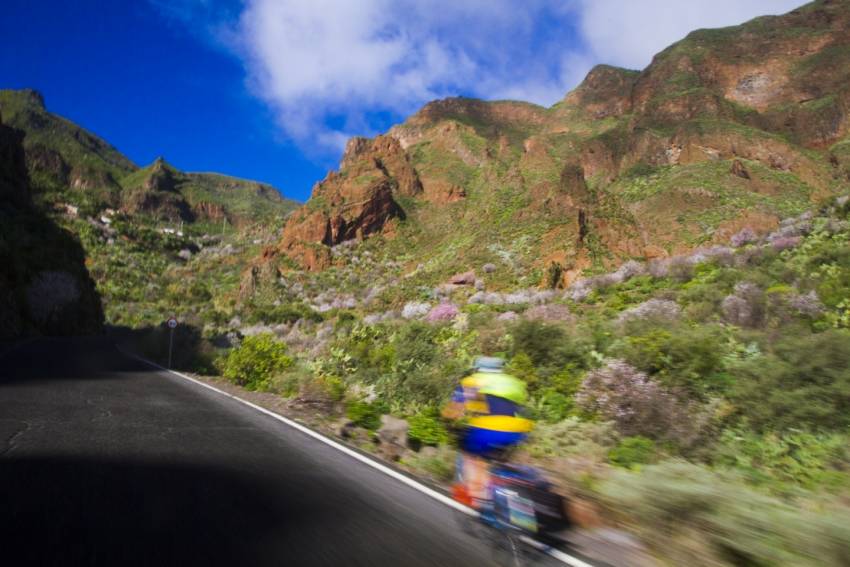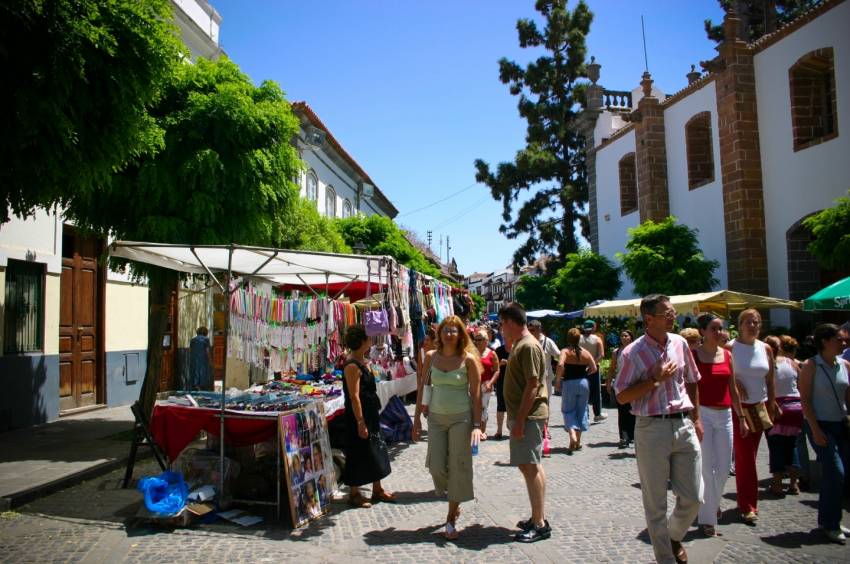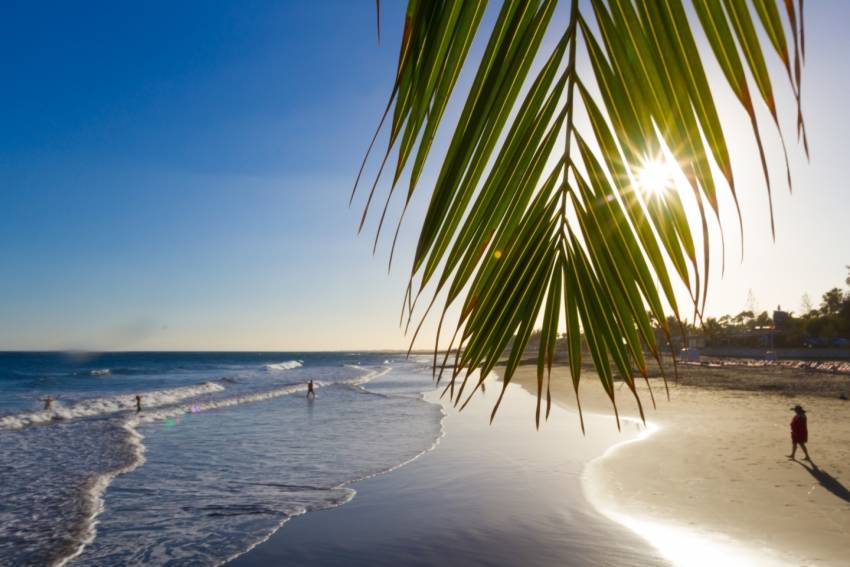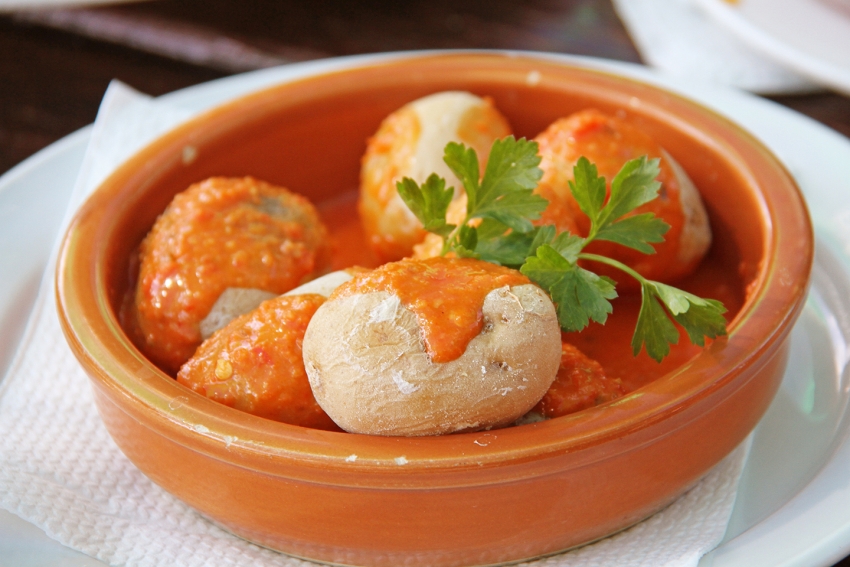Tunte Market: Local Produce For Local People
Tunte or San Bartolome de Tirajana market is a local affair held in the hill town early every Sunday morning.
San Fernando Market On Wednesdays And Saturdays
San Fernando market is one of the big three in south Gran Canaria along with Puerto Mgán and Arguineguín. The location isn't as pretty as its rivals but it's far more convenient if you're staying in Playa del Inglés or Maspalomas.
The stalls here sell everything from local produce to Moroccan leather (most are also at the other markets).
Faneroque Beach: Gran Canaria's Least Visited Beach
Faneroque beach makes the more famous GüiGüi beach feel like Puerto Rico on a busy Sunday afternoon. If you make it, and few do, you'll have it all to yourself except for the rusty bulldozer.
Popular Pebbles At Puerto de las Nieves
Puerto de las Nieves in north-west Gran Canaria is more famous for its seafood than its beach. A shame, as few realise that the area gets some of the best weather on the island and that PDLN beach is a calm, sunny haven with fishing boats on the pebbles rather than sun loungers.
Arinaga: Gran Canaria's Most Improved Town
Arinaga's attractive promenade, a great natural swimming pool and decent seafront restaurants make it an excellent east coast lunch and swim stop. Just up the road is the world-famous El Cabron dive site and the unassuming but ecologically important Arinaga dunes reserve.
Agüimes Hill Town
The cobbled old town, with its vast church and squat, heat-proof Canarian houses is the prettiest example of a Gran Canaria hill town in east Gran Canaria. It's well worth a wander.
Caves, Bees And Blossom At Guayadeque Gorge
The Guayadeque gorge is easily the most interesting day trip in East Gran Canaria, especially combined with Aguimes old town and an afternoon swim at Arinaga. It's also a pain in the neck for visitors.
You'll get one from looking up at the high cliff walls and cave houses, then from ducking into the cave houses and chapel. Even the restaurant at the end of the road is carved into the rock.
The hum
Sound carries in the gorge and you'll hear dogs barking from their cave kennels and the shrill cry of kestrels as they harry the buzzards overhead. And then you'll notice the hum.
From their hives clustered high up on the valley sides Guayadeque's bees feast on a rolling buffet of flowers. The first course is a feast of pink and white almond blossom in January, followed by yellow broom, purple lavendar and blue bugloss flowers. There's always something in flower here: Guayadeque is one of the most biodiverse spots in Europe, home to dozens of unique Canarian plants.
Try the honey in the cave shops by the chapel half way up the valley.
Cavemen
Guayadeque was a stronghold for the island's original inhabitants. They were the valley's first troglodytes and their traces are everywhere. Visit the interpretation centre at the beginning of the valley road for details on their lives here and the traces they left behind.
Modern day locals still live in cave houses in the valley, although many have turned them into rural houses for visitors. In the old days it wasn't just the people that lived in cavesbut entire farms with everything from cows to rabbits dwelling inside the rocks.
Alex Says: Guayadeque is vertigo-sufferers gateway to the landscapes of central Gran Canaria. You get the monumental cliffs and rocks of the cumbres without steep drop offs.
Frequently Asked Questions - FAQ
Here's a growing list of FAQs that we get at Gran Canaria Info. If your question isn't here, then please ask us in an email or via a Facebook message. We'll answer ASAP.
Can I drink the Tap Water in Gran Canaria?
The island's tap water is perfectly safe to drink, wash in, cook with and brush your teeth with. It just doesn't taste too good as it's made from desalinated seawater. Nobody on the island drink the tap water unfiltered and most buy drinking water in five or eight litre bottles.
Are there cockroaches?
There
Can I get marmite, sausages, teabags?
What’s the weather
Which resort
airport transfers
Nightlife
Touts
San Mateo: Gran Canaria's Farming Town
You don't see many wellies in Gran Canaria but San Mateo, as the island's main farming town, is where they are concentrated. With rich soils and plenty of rain, it's main focus has always been agriculture rather than tourism. Despite a madcap plan for a cable car that doesn't look like changing anytime soon.
Santa Brigida: Gran Canaria Hill Town With A Pretty Market
Santa Brigida town was used by the British as their summer Hill Station when they controlled the coal trade in Las Palmas port in the late 19th and early 20th Century. Nowadays it a quiet residential town with a great weekend market (and a great wine stall) and a couple of excellent restaurants.
Cliff Edge Views In Sleepy Moya
Moya has two claims for fame: Biscuits and a cliff-edge church square with a view of the deep Barranco behind the town. The view is spectacular, the biscuits not so much.
Moya church is a whitewashed Canarian church with stone edging in Neoclassical style. It's pretty but nothing more. However, it stands in a square right on the edge of the deep Barranco de Moya ravine. The view from the edge makes your tummy flip and is well worth a stop.
The town's famous bizcochos de Moya are much less exciting: Just dry biscuits with sugar on top that everyone in Gran Canaria has in the cupboard but nobody ever seems to eat.
Perhaps the real highlight of Moya is the walk around the Los Tilos de Moya laurel forest about five minutes drive from town. This is one of only two patches of laurels that survived the deforestation that followed colonisation and is one of the most biodiverse spots in Europe with dozens of rare Canarian plants. The circular walk takes you up the side of the valley and through the laurels.
Guia: Gran Canaria's Cheese Town
It says a lot about Guía that it's cheese is more famous than the actual town. It's pretty enough but a sleepy kind of place, especially compared with Galder next door.
Santa Maria de Guía's church square and the cobbled streets running off it have their charm. The problem with Guía from a vistor's point of view is that there isn't much do there except for look at it. The Sunday market in the square only has five stalls: It's the place to go to get great Flor de Guia cheese right at source but doesn't sell much else.
Flower cheese
Flor de Guía is a soft, creamy and slightly bitter goat and sheep cheese with a faint odour of socks. It comes in wheels only a few inches thick and tends to sag with age. It's great stuff and is made with cardoon flower sap rather than rennet, making it the only local cheese suitable for veggies.
Cheese festival
Guía perks up during the annual Fiesta de Queso (cheese festival) in April/ May. It's the time to visit with lots of cheese and food stalls and general celebrations of anything cheesy.
If you're in Guía outside fiesta time, head to La Quesera organic cafe for a great selection of local cheese and wine. It's in a 19th Century house and chapel and has an organic garden in its courtyard. The address is Calle Pérez Galdós 27.
God and Garlic Sausage In Teror
Teror is on all the lists of places you have to see in Gran Canaria and is one of the island's prettiest towns with lovely cobbled streets and wooden balconies. That said, the religious angle overwhelms all others in Teror, apart from the pungent sausage.
Agaete: Gran Canaria's White Town
"Come and visit, look around, then go away". Agaete's unofficial motto isn't exactly tourist board stuff but then this is a town that marches to the beat of its own drum. While most Canarian towns are much of a muchness, here's a few ways that Agaete stands out:
- It grows Europe's only coffee crop
- It's the island's most musical town but it's best musicians don't play local folkloric stuff
- It has Spain's highest unemployment rate but doesn't have a sign welcoming tourists
- It hosts the island's biggest party but is quiet the rest of the year
Sunken gardens, hidden graves, etc
Almost everything that makes Agaete such an interesting town is hidden from plain sight. The entrance to the gorgeous Huerto de las Flores sunken garden is down a lane, round the corner and through an arch, while caveman necropolis just outside the town is hidden on a lava flow.. The music scene only starts in the evenings once most visitors have driven back to their resort.
Do a 2,5h tour in english with a young inspiring and enthusiastic local, learn all about this beautiful village and pay as much as you like. Good deal? We certainly think so!
Yearly blow out
The annual Bajada de la Rama fiesta in Agaete is epic with almost 100,000 Canarians invading the town for a whole weekend. It's good natured bedlam and the procession, with thousands of green branches and giant papaguevo papier mache figures, is the island's best.
The valley of longevity
The deep Agaete Valley, the most fertile on the island, cleaves it's way to the sea from the high Tamadaba massif. The valley's inhabitants swear that drinking it straight from the rock springs brings good health and longevity. Filtered by pine forests and kilometres of rock it's certainly makes the plants grow. There more variety of tropical fruits and flowers here than anywhere else in the Canary Islands.
The other Gran Canaria
The Agaete Valley is where Gran Canaria's other tourists go: The walkers and winter visitors who wouldn't be seen dead in a resort but still want the island's great weather. As a rural tourist destination is has everything: Traditional houses, great walks, a quiet town full of character, a seaside enclave and even the island's highest rock climb.
We think the Agaete Valley is the island's most comple rural tourism destination and the place to go if you want to experience local life and still get a tan.
San Agustín Beach
Golden San Agustín beach somehow get's forgotten by the crowds heading for Playa del Inglés and Maspalomas and that's no bad thing. For a resort beach is quiet and laid back and there's plenty of places to eat and drink close by.
Top Tips For Hassle-free Car Rental In Gran Canaria
Most people rent a car in Gran Canaria and have no problems at all. Here's our guide to hassle-free rentals and our advice on choosing a good company and avoiding sneaky tricks.
Three Little Things You Have To Do In Las Palmas
Las Palmas is a Spanish city with a Canarian accent and a few South American flourishes. It's the only city in Europe where salsa and coconut palms thrive alongside mojo, tapas and vino tinto.
There are two ways to see Las Palmas: Get sore feet seeing the whole place in a day and ending up with a full memnory card and that fuzzy been-there done-that feeling that fades as soon as you move on.
Or, you can do laid-back Las Palmas at its own pace: Instead of charging around take your time doing very little, very thoroughly.
Start by sitting down and drinking a proper cofee
In Las Palmas coffee is made by grown ups instead of baristas and it's all the better for it: Pure bean juice unsullied by pretension, syrups and towers of cream. It comes served in a white porcelain cup with a paper bag of sugar and a tatty old teaspoon. It tastes of coffee.
Order a café solo for a pure espresso, a cortado for an espresso with a dash of milk and a café con leche for a latte. Or go for the rocket fuel option of the leche y leche: A cortado with a shot of condensed milk at the bottom.
In the summer, go for café con hielo. It’s a shot of espresso served with a glass full of ice cubes on the side. You pour the coffee over the ice, swizzle it around a bit and then drink. Simple and delicious.
Every bar and café in Las Palmas has a steam espresso machine so pick one with a good view. The Canteras beachfront, the cobbled streets of Vegueta and any of the palm-shaded squares are splendid spots for a coffee break.
Visit the Museo Canario
In the 1500s Spanish steel met the sticks and stones of the original Canarii inhabitants. It took them 100 years to conquer the Canary Islands, longer than it took to subdue the Aztecs and the Incas.
The unfortunate consequence of this Conquistador trial run was the extinction of Canarii culture. Their languages, religion, folk tales and music were obliterated. All we have left are their mummies and pottery: Meagre remnants of a race that considered themselves kings but didn’t understand the wheel.
The best collection of Canarii artefacts is in the Museo Canario or Canary Museum in Las Palmas’ historical Vegueta barrio. Thankfully, it is compact and not afraid to display plenty of skulls and mummies.
Spend an hour in the museum and then the day wandering around Vegueta. 500 years ago it was besieged by the same people now lying shrivelled in the museum: The only European city ever besieged by stone-age warriors. What if they had overrun the walls? The whole history of Spain and South America would be different.
Learn to Surf
Canteras Beach is three miles long and changes every 100 yards. The north end is all coconut palms, golden sand and clear water. It’s great for sunbathing and snorkelling.
The southern La Cicer end in front of Guanarteme barrio is the surfing end. Twenty years ago it was isolated within the city and overshadowed by fish-canning factories and a power plant. When the town hall shut down the factories and extended the promenade the barrio woke up. Its sullen pot-smoking surfers went to business school and opened surf schools and hostels.
The waves aren’t world class but they are consistent and the right size for beginners. Within a day you can learn the basics of surfing and then hit the bars for an introduction to local rum. Pace yourself because the city doesn’t liven up until midnight and dances until dawn.
There are no flamenco shows or tour guides dressed in traditional costumes in Las Palmas. Like its coffees, it is hot, full of flavour and completely free of pretension. That’s why we love it and you will too.
Las Palmas Guide For Cruise Ship Passengers
Ok, so you've arrived in Las Palmas and you have a few hours to see the city and a bit of Gran Canaria island. Where do you start?
Where In The World Can You Eat Old Clothes and Wrinkly Popes?
That would be the Canary Islands, where some traditional food dates back to prehistoric times but all of it is bursting with island flavour.
Gran Canaria Surfing: El Confital
The fast, barrelling, right-handed point break at El Confital is one of Europe's top bodyboarding waves and hosts European tour events regularly.
Gran Canaria Info recommends:
- Default
- Title
- Date
- Random


